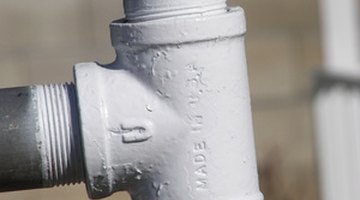Water Pressure in a Well & Septic System
The septic system and the well rely on pressure to move water through the system. The system should have specifications that describe what the system pressure should be. If the septic system or well has the wrong pressure, the system might have developed a leak or any number of other problems that indicate that the system needs to be repressurized or replaced. Sometimes, a lack of pressure can indicate a variety of minor issues, such as a switched-off main water valve.
Pipe System

A lack of water pressure can result from a problem with the piping that brings water to the septic system or well. During the winter, pipes can freeze, preventing water from flowing through the pipes. However, if the pipe receives damage from some source, that pipe might have burst. Listen to the areas where the pipes run for the sound of water.
Municipality
Sometimes the municipality has an effect on the water. If there is something wrong with the municipality's plumbing system, you might have a temporary water shutoff. Also, the municipality might cause you to experience intermittent water.
Water Pressure Regulator
If you have low water pressure, you might want to get a water pressure regulator. If you already have a water pressure regulator and the water pressure remains low or fluctuates, you might have a bad water pressure regulator that you need to replace.
Jet Vs. Sump Pump
The jet pump in well and septic systems is easier to install than the sump pump. Both can produce a lot of water pressure in the right systems, but the sump pump will last longer.
Leakage
The contractor who installs the septic system will tell you the levels of pressure that the septic system should have. If you notice any fluctuations in the septic system, the system might have a leak. A qualified contractor should inspect the septic system to ensure that everything is functioning properly. You should visually examine all of the joints in the septic system to determine if there are any leaks.
Pressurizing
If the tank gets waterlogged, the pressure in the septic system should surge periodically. When the water pressure is down and the pump is switched off, you should see if the pressure is lower than it's supposed to be. Try to repressurize the tank with a bike pump or a compressor. If water comes out of the air nipple when pressurizing, you will need to replace the tank. Before repressurizing the tank, ensure that the tank has almost no water.
References
Writer Bio
Charles Pearson has written as a freelancer since 2009. He has a B.S. in literature from Purdue University Calumet and is currently working on his M.A. He has written the ebooks "Karate You Can Teach Your Kids," "Macadamia Growing Handout" and "The Raw Food Diet."
Photo Credits
- pipe fitting image by Joann Cooper from Fotolia.com
More Articles



